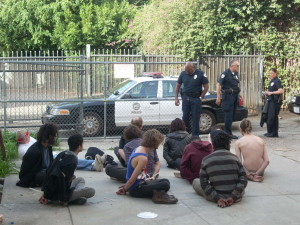
In 20131 the BID Patrol arrested homeless people at more than 57 times the rate that the LAPD did. Furthermore, they were responsible for more than 1% of all arrests made in the entire City of Los Angeles that year even while working only 0.13% of the hours that the LAPD did. Approximately one in fourteen arrests of homeless people in the entire city of Los Angeles that year was made by the BID Patrol.
Here’s how I calculated these figures: That year the LAPD made 14,838 arrests of homeless people2 whereas the Andrews International BID Patrol made 1,096 arrests.3 Reading through A/I’s 2013 arrest reports and examining A/I’s 2013 arrest photos I see no reason to believe that the BID Patrol arrested non-homeless people in 2013 in any significant number.4
I have been unable to find an accurate account of the number of hours the LAPD worked in 2013, but I estimate it to be 19,200,000 (details in the footnote).5 Thus in 2013 the LAPD arrested homeless people at a rate of
According to the 2013 Planning Report of the Hollywood Property Owners Alliance, the BID Patrol managed 416 patrol hours per week and about 80 hours for other employees. I’m using the total figure of 496 hours per week.6 Thus in 2013 the BID Patrol arrested homeless people at a rate of
Note that the figure for the LAPD is times bigger than the BID Patrol. In other words, in 2013, it took the LAPD 57.3 times more hours to arrest each homeless person than it took the BID Patrol.
This figure is even more astonishing when you consider that there are about 23,000 homeless people in the City of Los Angeles7 and, according to Kerry Morrison, during 2013 there were never more than 175 homeless people at a time in the two BIDs covered by the BID Patrol. That is, the LAPD made
whereas the BID Patrol made
Another way to look at the shocking import of these calculations is that in 2013 the LAPD made a total of 104,255 arrests.8 In 2013, as we’ve seen, the BID Patrol made 1,096 arrests. Thus more than 1% of all arrests made in the entire City of Los Angeles were made by the BID Patrol.9 This is amazing, considering that, as we’ve seen, the BID Patrol worked about 24,752 hours that year whereas the LAPD worked about 19,200,000. In other words, the BID Patrol worked about 0.13% as much as the LAPD.
I hope to write a follow-up post to this quite soon examining the effect that this off-the-chain behavior on the part of the BID could have on the homeless policies of the City of Los Angeles.
- This is a year for which I have extraordinarily accurate statistics available. I have no reason to think there’s anything exceptional about it.
- See Homelessness and the City of Los Angeles by Miguel Santana, City Administrative Officer. April 16, 2015. P.18.
- See 2013-YTD-TOTALS-WE-12-31-13.xls, which I obtained from the Hollywood Property Owners Alliance pursuant to the California Public Records Act.
- According to HPOA Executive Director Kerry Morrison the BID does not track this data, so it won’t be possible to find the actual figure.
- According to the California Policy Center, who analyzed a number of public records, LAPD officers work very little overtime. I’ll assume they work none, so 40 hours per week, 48 weeks per year, per officer. Note that I’m assuming 48 weeks per year per officer because that makes the calculations more favorable to A/I. In 2013 the LAPD had very close to 10,000 sworn officers. This is 40 hours per week x 48 weeks per year per officer x 10,000 officers = 19,200,000 hours per year.
- Making this number larger yields an estimate that’s more favorable to Andrews International. The information appears on page 5 of the linked report.
- Again according to Santana’s report
- Santana’s report again.
- It’s not possible to determine from the data I have whether the BID Patrol’s arrests are included in the LAPD’s figure. It would make sense if they were, because the LAPD has to accept custody of every person that the BID Patrol arrests. It would also make sense if they were not, as in some sense private persons’ arrests are not made by the LAPD. In any case, the numbers change very little between the case where they’re included and the case where they’re not.
